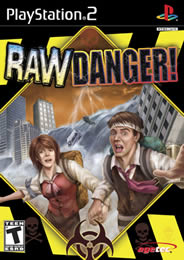
Raw Danger
How important is “reality” in game world design and characters? Are we interested in “real” characters in “real” situations? Many of the games we play are set in purely and unapologetically fantasy-based settings, featuring goblins, wizards, space ships, flying purple dragons and a million other things we don’t generally see in real life . . . assuming we’re not total drug causalities. To be sure, there are “reality” based games as well, to be sure, but most of these take place in a very extreme situation, like war, or elite car racing, or something equally non-day-to-day.
Generally, even if you are playing a “reality” based game, chances are you’re playing as some over-the-top hero type, right?
When it comes to characters, it’s most commonly the adventure game genre that features “regular” people as characters. Usually, those regular folks are inserted into some sort of extraordinary situation, and it almost always is a situation that the player would be unlikely to encounter in real life. This is cool and fun, because it makes it easy to identify with the “ordinary” person in the extraordinary situation.
Enter Disaster Report, Agetec’s innovative 2003 action/adventure about a regular guy trying to survive a major earthquake in a large city. I admired the game’s ideas, but didn’t enjoy the sub-par graphics or the lack of direction in the gameplay.
Well, it’s four years later, and Agetec has tried again with Raw Danger. And this time, they got a lot more right.
As the game begins, you play a young waiter who’s caught in a disastrous flood in a large city. The object of the game: survive. Now, that’s actually a fairly revolutionary game concept, if you think about it, because any one of us could actually find ourselves in such a situation. (Especially if you live anywhere near Houston these days.)
The setup is oddly reminiscent of that of a much more hyped game that was released this week: Bioshock. Both games take place in a model city that’s been the brainchild of a visionary and yet, rather than becoming the utopia it was intended to be, it turns into a nightmare.
Trust me, lots more people will play Bioshock than will play Raw Danger. But that doesn’t mean RDdoesn’t deserve a look if you’re an adventure fan with a PS2.
Before we go any further, let’s talk genre definitions for just a minute. I generally don’t label a game action/adventure unless there’s a lot of combat. Since there’s no combat in Raw Danger, I could make a good argument that it’s a pure adventure game. However, every one of its puzzles and challenges are so action-oriented, I’m comfortable with the label action/adventure. In this game, you’re not going to be solving slider puzzles. You’ll be figuring out how to get from point A to point B without drowning, falling, or dying of hypothermia.
Before the game starts, there’s an optional tutorial that’s well put-together. It takes place in the city’s Disaster Preparedness Office, and in it you progress through five rooms learning the basics of gameplay movement and actions, including walking, running, jumping, clinging, etc..
When the game proper begins, you are a waiter at a very posh affair in the visionary city of Del Ray in late December, 2010. The event is celebrating a major new development of the metropolis called Geo City. It’s basically a photo op for the mayor, who’s the man behind the new development. The tone is veryTitanic as speeches are made about the City of the Future which will take away all sorrow and drudgery and what could possibly go wrong?
As a lowly waiter, you begin by doing a series of mundane, waiterly chores. As you pass between the banquet hall and the kitchen, however, you begin to notice that water is seeping in from the outside. Soon it’s an all-out flood and panic erupts! From this point on it’s your job to survive the various calamities that the flood is visiting upon the city. The first task is to simply get out of the crumbling banquet building alive.
Along the way you end up helping a young woman, a fellow member of the wait staff. She’s got an important father, a stepmother in the hospital, and lots of other interesting baggage. The game lets you decide how much to help her and how nice you’re going to be to her.
After narrowly escaping the building, your young waiter faces a serious of dangerous challenges as the whole city threatens to collapse under the deluge. In a nod to the early PS2 classic Ico, there are times when you are strong enough to make it somewhere but then you’ll have to figure out another way to rescue some weaker, or incapacitated, person.
As you run through the collapsing city, you have the opportunity to pick things up and put them into your inventory. Some of the time this will be a way to replace your wardrobe (you stay warmer in a raincoat than in a waiter’s outfit). Some times you’ll find health-regenerating food. And, of course, sometimes you’ll find tools that can help you out of dangerous situations. You can’t carry much, so you’re constantly having to make decisions on what to take and what to leave behind.
All of the puzzles in the game are environmental, and require you to use your surroundings and any inventory that you’ve collected to solve your immediate problem. You can combine and even disassemble objects in your inventory.
Unlike most PC adventures, you cannot save anywhere you like. You can only save at places of warmth, like stoves, burning trash barrels, etc. Saving the game also dries your clothes and warms you back up. You have to pay close attention to your body temperature as you’re running around, or it will dip so low that you will be unable to run. Let yourself get too cold and your character will die.
Another way the game adds interest (and replay value, a rarity in an adventure game) is that you have meaningful choices at various points in the story. Help the girl, don’t help the girl. Help the girl find her stepmother in the hospital, tell her to forget it, or convince HER to forget it and come with you.
Another interesting element to the game is that, in the course of the adventure, you’ll get to play as five different characters, each with his or her own story. Even more cool, all of these stories and characters overlap and take place during generally the same time frame, so the stories sometimes overlap and can even be affected by choices you make. For example, in the first story your waiter hears about an escaped “murder suspect.” At one point you actually see this suspect and have to choose whether or not to alert a cop. The suspect is your second playable character, so your choice will totally affect her story.
Adding to the interconnectedness of the various storylines is the fact that you can actually leave inventory objects in specially designated bins for other characters to pick up.
As mentioned above, all of these choices (as well as a fairly silly but harmless object collection minigame) give the game actual replay value. What will happen if you don’t tell the cops you see the murder suspect? What will happen if you behave like Prince Charming to the girl? What will happen if you help the man with amnesia?
In terms of always knowing what your objective is, the game is much improved from its predecessor. This helps keep you focused and involved.
The audio in the game is just average. Sometimes there’s very questionable sound balance between dialog and background noise. Plus, no effort was made to match the lip-synching of the characters to English. However, the water sounds are respectable and effective.
The score is fairly cheesy, about on par with a made-for-cable movie.
Sometimes the dialog is stilted and at others terribly translated from the Japanese.
I don’t want to oversell this low-budget PS2 action/adventure. However, it does have a lot going for it: putting the player in a dangerous yet unusually real situation, meaningful story choices, and lots of replay value. You might be surprised how much you end up enjoying Raw Danger. Just remember: Stay warm!!

Leave a Reply